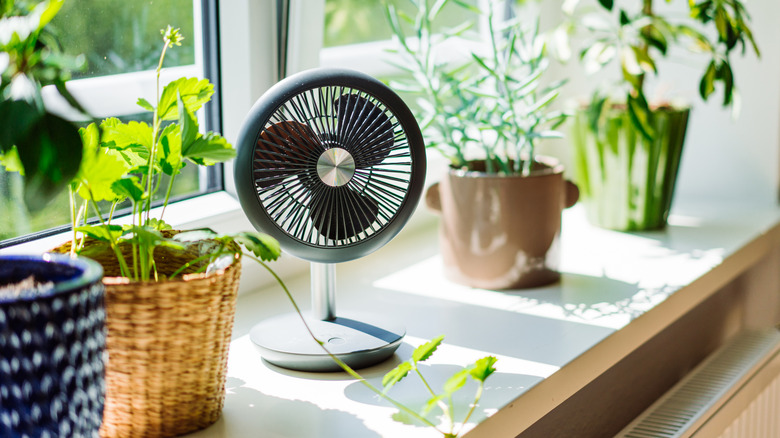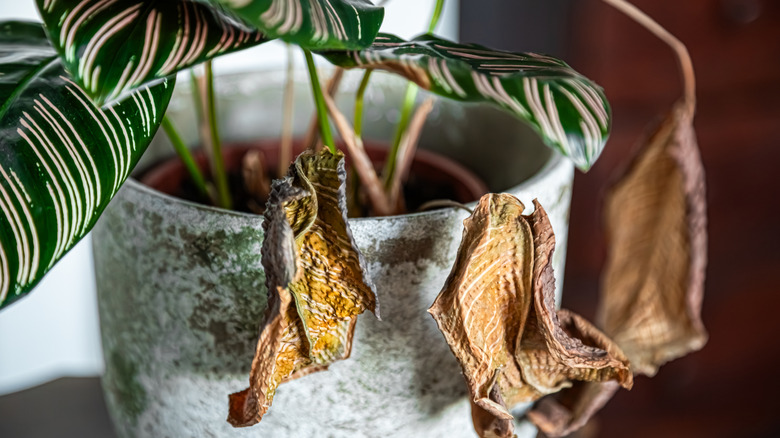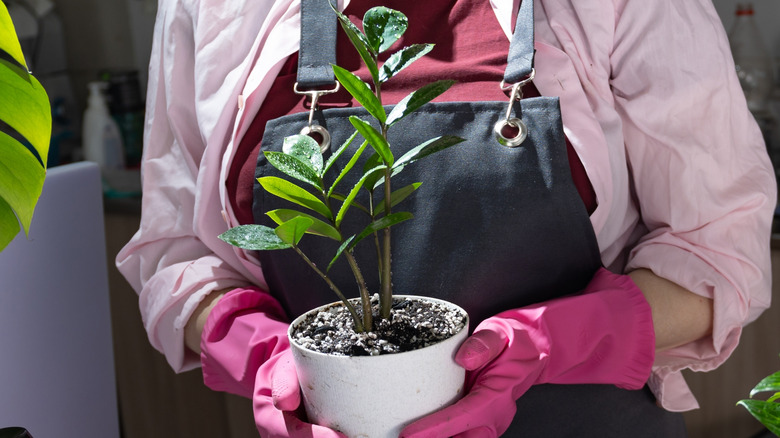The Common Heatwave Watering Mistake That Could Kill Your Houseplants
When you're going through a heat wave, you might reach for water at every opportunity, knowing that staying hydrated is important. The plants in your home should also get every possible drop of water, right? Well, the answer isn't as intuitive as you might think. While it's a good idea to monitor them extra closely in extreme heat, watering plants too much during a heatwave is a common mistake that can harm or even kill them.
There are several reasons your plants may need more water in hot weather. They're out of their comfort zone: The ideal temperature setting for flourishing houseplants is between 70 and 80 degrees Fahrenheit during the day, which could be exceeded during a heat wave. Higher soil temperatures can easily stress out a plant, leading to wilting and leaf curling. And in an effort to keep cool, the plant will evaporate water more quickly than it would in cooler temperatures.
It's understandable to want to give a plant more water when noticing these symptoms, but more doesn't mean too much. The watering should be thorough (with the water draining out of the bottom of the pot), but water needs vary based on the type of plant and the conditions it lives in. Some houseplants thrive in dry climates and are especially sensitive to overly moist soil, and that doesn't change in a heat wave. Instead of watering with abandon, make sure to check your plants often during periods of high heat to determine how much water they actually need. This will save you from getting carried away and causing deadly conditions like root rot.
Overwatering is dangerous, even in extreme heat
If you overwater a houseplant in the middle of a heatwave, it paradoxically may not be able to take up enough of a drink. Too much water takes away oxygen from the soil and damages the roots that plants use to absorb water. As the barrage of water continues, or the soil isn't drained, the plant's leaves can turn yellow or drop off, and the plant may ultimately die. Root rot, caused by fungi that live in moist soil, is also a danger if you overwater your houseplants through long stretches of hot weather. Houseplants are more at risk of being suffocated by overwatering than outdoor plants, since the water can pool under their pots rather than draining away.
Overwatering can even lead to symptoms that cause well-meaning plant parents to add more unnecessary water. If root rot affects the plant, it might look like it needs more water because of its wilting or drooping, but that would just make the problem worse. Some forms of root rot that happen in warm environments have dramatic consequences. For example, Rhizoctonia rot is a fungal affliction that can make the plant's stems turn brown and cause your once-green beauty to collapse. Houseplants severely affected by this type of rot need to be removed, so the best option is to prevent it by not overwatering.
How to avoid overwatering houseplants in high heat
The best way to avoid dangerously drenching your plants as temperatures rise is to pay attention to their condition, rather than relying on the calendar. To make sure you never overwater your plants again, only water when the top of the soil feels dry, or stick a dowel into the soil to check if it's still moist (you'll know if it sticks to the dowel that the plant has some time to go). You'll also know the plant has enough water if the pot feels heavy when you pick it up. Using your senses to interpret whether your plant needs water is a better method than shelling out for a moisture meter, which can be confusing to interpret.
When you do water plants during a heat spell, make sure you give them a satisfying drink rather than a sprinkle. Water should drain from the bottom of the pot after a minute. Your plants will have the best chance of resisting root rot if they're in a container that drains well, so make sure there are adequate drainage holes at the bottom of the pot and that you empty the drainage tray within an hour of watering.
You can take extra steps to help houseplants weather a scorcher. If you situate plants next to each other or turn on a humidifier nearby, you'll increase humidity, which can reduce their need for water by providing moisture in the air itself. You can also bring them into more naturally humid spaces, like the bathroom or kitchen.


